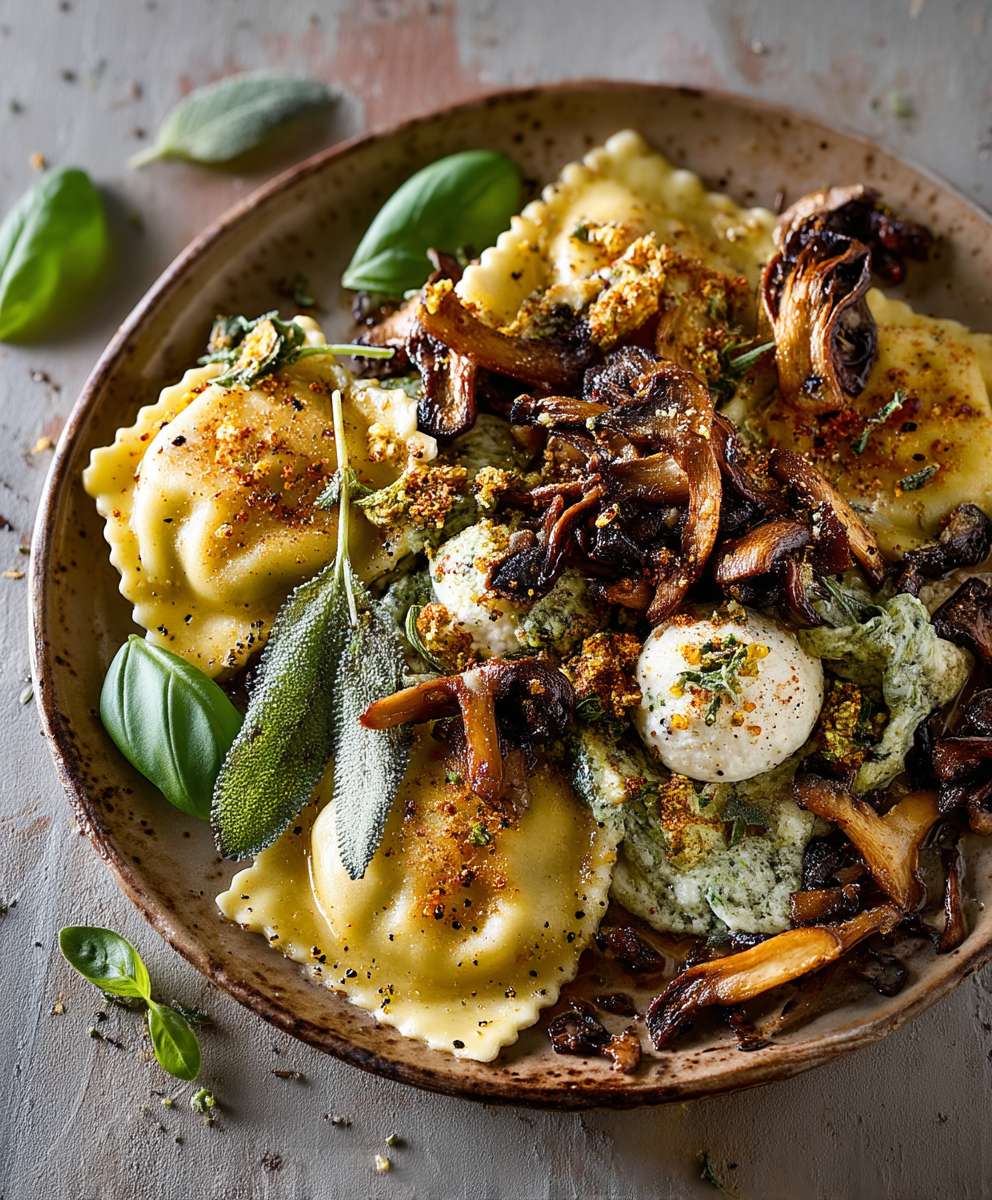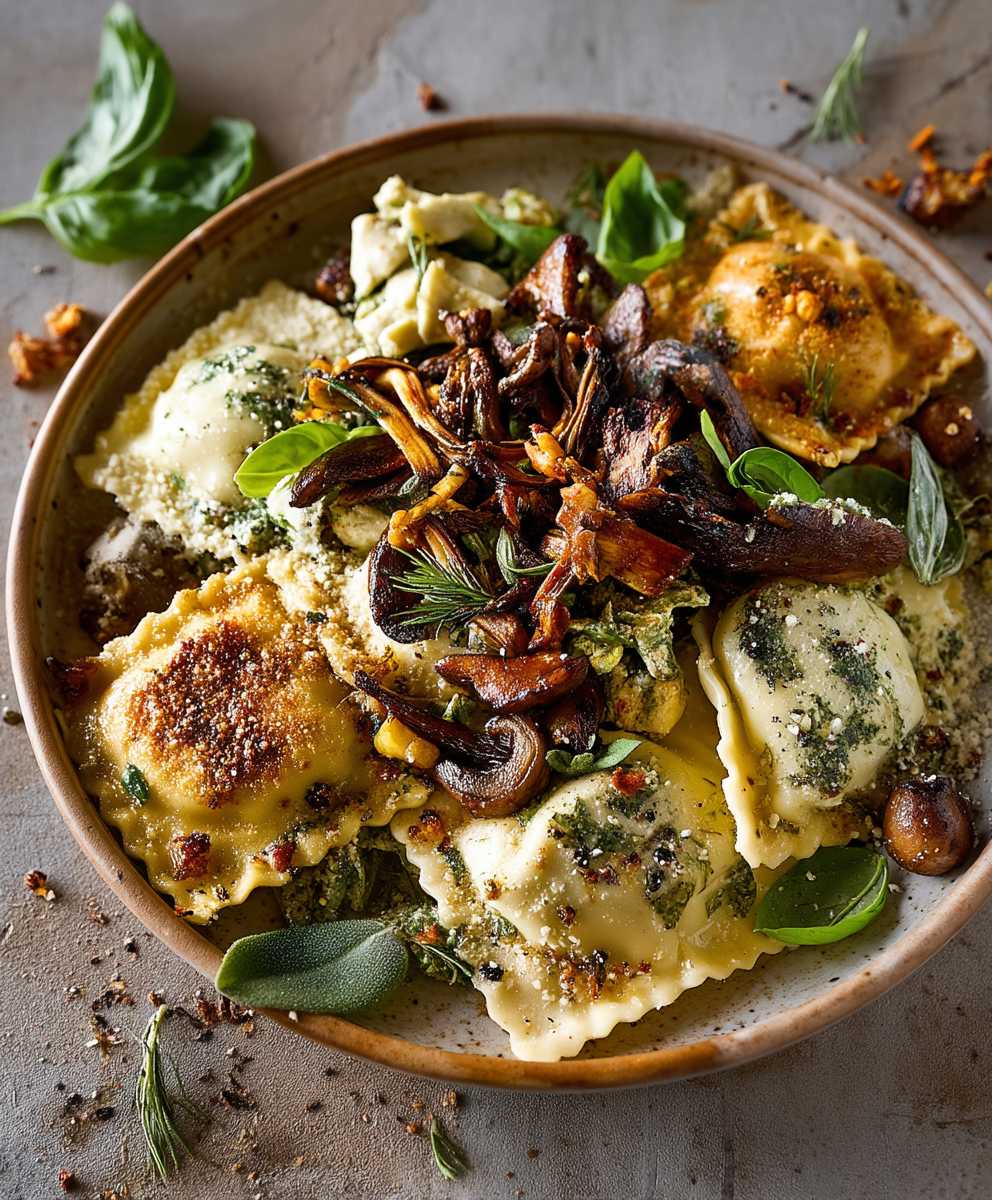Sage Garlic Butter Ravioli: Prepare to embark on a culinary journey that will tantalize your taste buds and leave you craving more! Imagine plump, pillowy ravioli, each one bursting with a savory filling, enveloped in a luscious, fragrant sauce of browned butter, aromatic sage, and pungent garlic. This isn’t just a meal; it’s an experience.
Ravioli, a cornerstone of Italian cuisine, boasts a rich history dating back to the 14th century. While its exact origins are debated, it’s clear that this pasta pocket has been delighting palates for centuries. From humble peasant fare to elegant restaurant dishes, ravioli has proven its versatility and enduring appeal.
What makes sage garlic butter ravioli so irresistible? It’s the perfect marriage of simplicity and sophistication. The nutty, browned butter sauce, infused with the earthy notes of sage and the sharp bite of garlic, elevates the humble ravioli to new heights. People adore this dish because it’s quick and easy to prepare, yet delivers a restaurant-quality flavor profile. The combination of textures the tender pasta, the creamy filling, and the silky sauce creates a symphony in your mouth. Whether you’re looking for a comforting weeknight dinner or an impressive dish to serve guests, this sage garlic butter ravioli recipe is guaranteed to be a crowd-pleaser. Get ready to experience a taste of Italy in your own kitchen!
Ingredients:
- For the Ravioli Dough:
- 3 cups (375g) all-purpose flour, plus more for dusting
- 4 large eggs
- 1 tablespoon olive oil
- 1/2 teaspoon salt
- 2-4 tablespoons water, if needed
- For the Ravioli Filling:
- 1 pound (450g) ricotta cheese, drained
- 1/2 cup grated Parmesan cheese
- 1/4 cup chopped fresh parsley
- 1 clove garlic, minced
- 1/4 teaspoon nutmeg
- Salt and freshly ground black pepper to taste
- For the Sage Garlic Butter Sauce:
- 1/2 cup (1 stick) unsalted butter
- 6 cloves garlic, minced
- 1/4 cup fresh sage leaves, chopped
- 1/4 cup grated Parmesan cheese, for serving
- Salt and freshly ground black pepper to taste
Making the Ravioli Dough
- Combine Dry Ingredients: In a large bowl, whisk together the flour and salt. This ensures the salt is evenly distributed throughout the dough.
- Create a Well: Make a well in the center of the flour mixture. This is where we’ll add the wet ingredients.
- Add Wet Ingredients: Crack the eggs into the well, then add the olive oil.
- Mix the Dough: Using a fork, gradually incorporate the flour into the eggs, starting from the inside of the well and working your way outwards. Continue mixing until a shaggy dough forms.
- Knead the Dough: Turn the dough out onto a lightly floured surface. Knead for 8-10 minutes, or until the dough is smooth and elastic. If the dough is too dry, add water, 1 tablespoon at a time, until it comes together. If it’s too sticky, add a little more flour. Kneading is crucial for developing the gluten, which gives the ravioli its structure.
- Rest the Dough: Wrap the dough tightly in plastic wrap and let it rest at room temperature for at least 30 minutes, or up to 1 hour. This allows the gluten to relax, making the dough easier to roll out.
Preparing the Ravioli Filling
- Drain the Ricotta: Place the ricotta cheese in a fine-mesh sieve lined with cheesecloth or paper towels. Let it drain for at least 30 minutes, or up to 1 hour, to remove excess moisture. This prevents the filling from being too watery.
- Combine Ingredients: In a medium bowl, combine the drained ricotta cheese, Parmesan cheese, parsley, minced garlic, and nutmeg.
- Season to Taste: Season the filling with salt and freshly ground black pepper to taste. Be generous with the seasoning, as the filling will be enclosed in the dough.
- Mix Well: Mix all the ingredients together until well combined. Set aside until ready to use.
Assembling the Ravioli
- Divide the Dough: Cut the rested dough in half. Keep one half wrapped in plastic wrap to prevent it from drying out while you work with the other half.
- Roll Out the Dough: On a lightly floured surface, roll out the dough as thinly as possible, about 1/16 inch thick. A pasta machine is highly recommended for this step, as it ensures a consistent thickness. If using a pasta machine, start with the widest setting and gradually decrease the setting until you reach the desired thickness.
- Lay Out the Dough: Lay the rolled-out dough on a lightly floured surface.
- Add the Filling: Place small mounds of the ricotta filling (about 1 teaspoon each) onto the dough, spacing them about 1-2 inches apart.
- Prepare the Second Sheet: Roll out the second half of the dough in the same manner as the first.
- Cover the Filling: Gently lay the second sheet of dough over the filling, being careful not to trap any air.
- Seal the Ravioli: Press down around each mound of filling to seal the dough together. You can use your fingers or a ravioli stamp for this. Make sure the edges are well sealed to prevent the filling from leaking out during cooking.
- Cut the Ravioli: Use a ravioli cutter, knife, or pizza cutter to cut out individual ravioli.
- Repeat: Repeat the process with the remaining dough and filling.
- Dust with Flour: Lightly dust the finished ravioli with flour to prevent them from sticking together.
Cooking the Ravioli
- Bring Water to a Boil: Bring a large pot of salted water to a rolling boil. The salt helps to season the ravioli and prevent them from sticking together.
- Cook the Ravioli: Gently drop the ravioli into the boiling water, being careful not to overcrowd the pot. Cook for 3-5 minutes, or until the ravioli float to the surface and are tender. The cooking time will vary depending on the thickness of the dough.
- Remove the Ravioli: Use a slotted spoon to carefully remove the ravioli from the water and transfer them to a plate.
Making the Sage Garlic Butter Sauce
- Melt the Butter: In a large skillet over medium heat, melt the butter.
- Add Garlic: Add the minced garlic to the melted butter and cook for 1-2 minutes, or until fragrant. Be careful not to burn the garlic.
- Add Sage: Add the chopped sage leaves to the skillet and cook for 1 minute, or until they release their aroma.
- Season the Sauce: Season the sauce with salt and freshly ground black pepper to taste.
Serving the Ravioli
- Combine Ravioli and Sauce: Add the cooked ravioli to the skillet with the sage garlic butter sauce and gently toss to coat.
- Serve Immediately: Serve the ravioli immediately, garnished with grated Parmesan cheese.
Tips for Success
- Don’t Overcook the Ravioli: Overcooked ravioli will be mushy and the filling may leak out. Cook them just until they float to the surface and are tender.
- Make Ahead: The ravioli can be made ahead of time and frozen. To freeze, lay the ravioli in a single layer on a baking sheet lined with parchment paper. Freeze for at least 2 hours, or until solid. Then, transfer the frozen ravioli to a freezer bag or container. Cook directly from frozen, adding a few minutes to the cooking time.
- Experiment with Fillings: Feel free to experiment with different fillings. Some other popular options include spinach and ricotta, mushroom and truffle, or butternut squash.
- Use Fresh Ingredients: Using fresh, high-quality ingredients will make a big difference in the flavor of the ravioli.
- Adjust Seasoning: Taste the filling and sauce as you go and adjust the seasoning to your liking.
Troubleshooting
- Dough is Too Dry: If the dough is too dry and crumbly, add water, 1 tablespoon at a time, until it comes together.
- Dough is Too Sticky: If the dough is too sticky, add a little more flour.
- Filling is Too Watery: Make sure to drain the ricotta cheese well to remove excess moisture.
- Ravioli are Leaking: Make sure the edges of the ravioli are well sealed to prevent the filling from leaking out during cooking.
- Sauce is Too Thin: If the sauce is too thin, you can add a little bit of cornstarch or flour to thicken it. Mix 1 teaspoon of cornstarch or flour with 1 tablespoon of cold water to make a slurry. Add the slurry to the sauce and cook until thickened.
Variations
- Brown Butter Sage Sauce: For a richer flavor, brown the butter before adding the garlic and sage. Cook the butter over medium heat until it turns a golden brown color and has a nutty aroma. Be careful not to burn the butter.
- Lemon Sage Butter Sauce: Add a squeeze of lemon juice to the sage garlic butter sauce for a bright and tangy flavor.
- Creamy Sage Sauce: Add 1/2 cup of heavy cream to the sage garlic butter sauce for a creamy and decadent sauce.
- Add Vegetables: Sauté some chopped

Conclusion:
This Sage Garlic Butter Ravioli isn’t just a meal; it’s an experience. The aromatic sage, the pungent garlic, and the rich butter create a symphony of flavors that perfectly complement the delicate ravioli. It’s a dish that’s both comforting and elegant, simple to prepare yet impressive enough for a special occasion. Trust me, once you taste the magic of this combination, you’ll understand why it’s a must-try recipe!
But why is this recipe a must-try? Because it elevates a simple pasta dish into something truly extraordinary. The browned butter sauce, infused with the earthy notes of sage and the sharp bite of garlic, clings beautifully to each ravioli, creating a burst of flavor with every bite. It’s quick enough for a weeknight dinner but sophisticated enough to serve to guests. Plus, the aroma that fills your kitchen while you’re cooking is simply divine! It’s a sensory experience from start to finish.
Looking for serving suggestions? I love to serve this ravioli with a simple side salad of arugula and shaved Parmesan cheese, dressed with a light lemon vinaigrette. The peppery arugula and salty Parmesan provide a lovely contrast to the richness of the pasta. You could also add some toasted pine nuts for a bit of crunch. For a heartier meal, consider adding some grilled chicken or shrimp to the dish. The possibilities are endless!
And speaking of possibilities, don’t be afraid to experiment with variations! If you’re not a fan of sage, try using fresh thyme or rosemary instead. You could also add a pinch of red pepper flakes to the butter sauce for a little bit of heat. For a vegetarian option, use cheese ravioli or spinach and ricotta ravioli. If you’re feeling adventurous, try making your own ravioli from scratch! It’s a bit more time-consuming, but the results are well worth the effort. You can even experiment with different fillings, like butternut squash or mushroom.
This Sage Garlic Butter Ravioli is incredibly versatile and easily adaptable to your own tastes and preferences.
I’m confident that you’ll love this recipe as much as I do. It’s a guaranteed crowd-pleaser, and it’s sure to become a staple in your kitchen. The beauty of this dish lies in its simplicity and the quality of the ingredients. Using fresh sage and good-quality butter makes all the difference. Don’t skimp on the garlic either! It’s what gives the sauce its signature flavor.
So, what are you waiting for? Grab your ingredients and get cooking! I promise you won’t be disappointed. And once you’ve tried it, I’d love to hear about your experience. Did you make any variations? What did you serve it with? Share your photos and comments below! I’m always looking for new ideas and inspiration. Let’s create a community of ravioli lovers!
I truly believe that this Sage Garlic Butter Ravioli recipe is a winner. It’s a simple, delicious, and versatile dish that’s perfect for any occasion. From a quick weeknight meal to an elegant dinner party, this recipe is sure to impress. So go ahead, give it a try, and let me know what you think! Happy cooking!
Sage Garlic Butter Ravioli: A Delicious & Easy Recipe
Homemade ricotta ravioli with a fragrant sage garlic butter sauce. A classic Italian comfort food perfect for a special occasion or a cozy weeknight dinner.
Ingredients
- 3 cups (375g) all-purpose flour, plus more for dusting
- 4 large eggs
- 1 tablespoon olive oil
- 1/2 teaspoon salt
- 2-4 tablespoons water, if needed
- 1 pound (450g) ricotta cheese, drained
- 1/2 cup grated Parmesan cheese
- 1/4 cup chopped fresh parsley
- 1 clove garlic, minced
- 1/4 teaspoon nutmeg
- Salt and freshly ground black pepper to taste
- 1/2 cup (1 stick) unsalted butter
- 6 cloves garlic, minced
- 1/4 cup fresh sage leaves, chopped
- 1/4 cup grated Parmesan cheese, for serving
- Salt and freshly ground black pepper to taste
Instructions
- Combine Dry Ingredients: In a large bowl, whisk together the flour and salt.
- Create a Well: Make a well in the center of the flour mixture.
- Add Wet Ingredients: Crack the eggs into the well, then add the olive oil.
- Mix the Dough: Using a fork, gradually incorporate the flour into the eggs, starting from the inside of the well and working your way outwards. Continue mixing until a shaggy dough forms.
- Knead the Dough: Turn the dough out onto a lightly floured surface. Knead for 8-10 minutes, or until the dough is smooth and elastic. If the dough is too dry, add water, 1 tablespoon at a time, until it comes together. If it’s too sticky, add a little more flour.
- Rest the Dough: Wrap the dough tightly in plastic wrap and let it rest at room temperature for at least 30 minutes, or up to 1 hour.
- Drain the Ricotta: Place the ricotta cheese in a fine-mesh sieve lined with cheesecloth or paper towels. Let it drain for at least 30 minutes, or up to 1 hour, to remove excess moisture.
- Combine Ingredients: In a medium bowl, combine the drained ricotta cheese, Parmesan cheese, parsley, minced garlic, and nutmeg.
- Season to Taste: Season the filling with salt and freshly ground black pepper to taste.
- Mix Well: Mix all the ingredients together until well combined. Set aside until ready to use.
- Divide the Dough: Cut the rested dough in half. Keep one half wrapped in plastic wrap to prevent it from drying out while you work with the other half.
- Roll Out the Dough: On a lightly floured surface, roll out the dough as thinly as possible, about 1/16 inch thick. A pasta machine is highly recommended.
- Lay Out the Dough: Lay the rolled-out dough on a lightly floured surface.
- Add the Filling: Place small mounds of the ricotta filling (about 1 teaspoon each) onto the dough, spacing them about 1-2 inches apart.
- Prepare the Second Sheet: Roll out the second half of the dough in the same manner as the first.
- Cover the Filling: Gently lay the second sheet of dough over the filling, being careful not to trap any air.
- Seal the Ravioli: Press down around each mound of filling to seal the dough together. You can use your fingers or a ravioli stamp for this.
- Cut the Ravioli: Use a ravioli cutter, knife, or pizza cutter to cut out individual ravioli.
- Repeat: Repeat the process with the remaining dough and filling.
- Dust with Flour: Lightly dust the finished ravioli with flour to prevent them from sticking together.
- Bring Water to a Boil: Bring a large pot of salted water to a rolling boil.
- Cook the Ravioli: Gently drop the ravioli into the boiling water, being careful not to overcrowd the pot. Cook for 3-5 minutes, or until the ravioli float to the surface and are tender.
- Remove the Ravioli: Use a slotted spoon to carefully remove the ravioli from the water and transfer them to a plate.
- Melt the Butter: In a large skillet over medium heat, melt the butter.
- Add Garlic: Add the minced garlic to the melted butter and cook for 1-2 minutes, or until fragrant.
- Add Sage: Add the chopped sage leaves to the skillet and cook for 1 minute, or until they release their aroma.
- Season the Sauce: Season the sauce with salt and freshly ground black pepper to taste.
- Combine Ravioli and Sauce: Add the cooked ravioli to the skillet with the sage garlic butter sauce and gently toss to coat.
- Serve Immediately: Serve the ravioli immediately, garnished with grated Parmesan cheese.
Notes
- Don’t Overcook the Ravioli: Overcooked ravioli will be mushy and the filling may leak out. Cook them just until they float to the surface and are tender.
- Make Ahead: The ravioli can be made ahead of time and frozen. To freeze, lay the ravioli in a single layer on a baking sheet lined with parchment paper. Freeze for at least 2 hours, or until solid. Then, transfer the frozen ravioli to a freezer bag or container. Cook directly from frozen, adding a few minutes to the cooking time.
- Experiment with Fillings: Feel free to experiment with different fillings. Some other popular options include spinach and ricotta, mushroom and truffle, or butternut squash.
- Use Fresh Ingredients: Using fresh, high-quality ingredients will make a big difference in the flavor of the ravioli.
- Adjust Seasoning: Taste the filling and sauce as you go and adjust the seasoning to your liking.
- Dough is Too Dry: If the dough is too dry and crumbly, add water, 1 tablespoon at a time, until it comes together.
- Dough is Too Sticky: If the dough is too sticky, add a little more flour.
- Filling is Too Watery: Make sure to drain the ricotta cheese well to remove excess moisture.
- Ravioli are Leaking: Make sure the edges of the ravioli are well sealed to prevent the filling from leaking out during cooking.
- Sauce is Too Thin: If the sauce is too thin, you can add a little bit of cornstarch or flour to thicken it. Mix 1 teaspoon of cornstarch or flour with 1 tablespoon of cold water to make a slurry. Add the slurry to the sauce and cook until thickened.
- Brown Butter Sage Sauce: For a richer flavor, brown the butter before adding the garlic and sage. Cook the butter over medium heat until it turns a golden brown color and has a nutty aroma. Be careful not to burn the butter.
- Lemon Sage Butter Sauce: Add a squeeze of lemon juice to the sage garlic butter sauce for a bright and tangy flavor.
- Creamy Sage Sauce: Add 1/2 cup of heavy cream to the sage garlic butter sauce for a creamy and decadent sauce.





Leave a Comment